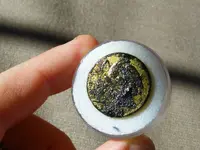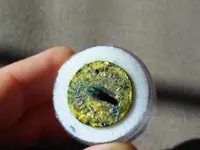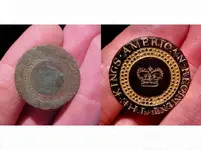Thanks all. I was asked to provide the recovery story as to another button I posted today, and since it's the same as this one, I'll post that story here as well. I lived in a condo in downtown Norfolk from 1994-1998. Much of the original city had been razed in the 50s and 60s, and converted into parking lots. Directly across the street from our condo were some parking lots that in 1998 were being torn up and converted into upscale apartments. I had detected the lots and found a few things, but there was lots of trash, the ground was difficult to dig, and all in all, it was kind of frustrating. One night - the night of the last episode of Seinfeld - I came home and noted that at one end of the lot they'd gone down maybe 8-12" in a strip maybe 30' x 100'. Well, my wife and I watched the show, it got to be around 9 PM, i was a little lazy and unmotivated, but I finally heaved myself up and went to check out the area where they had gone down. And am I glad I did! They had gone to a historic layer, with no modern trash at all, where every signal was an artifact. I found a big penny (1820), and 6 or 7 War of 1812(ish) buttons. I've posted most of those in the last couple of weeks, but they include this button, a Navy and a general service US button posted in this forum yesterday, a Navy and a Marine button posted yesterday in the Best Finds forum, and a Republique Francais button posted in the Best Finds forum last week. My best night of detecting ever. One last point - the only other thing I found, in addition to all this 1810-1820 stuff, was a bunch of tokens that I posted a couple weeks ago. I haven't had a good ID on those. They look modern, but how a dozen or so of the exact same tokens could be found scattered in the same area where everything else was from the same era, and not themselves be of that era, is beyond me. I've bumped that token post up one last time, and if anyone can give me a better idea of what they might be, I'd appreciate it. And thanks for reading this!






 The issue with the lemon is making the non plated surface pit, and of course turn the button from or black when the corrosion leaves. Any color issue you'd have ....purple... orange, or whatever, would be a button that had no plating remaining. But if it's covered with corrosion it's still better to soak it and have some clear detail than leave it caked with crud.
The issue with the lemon is making the non plated surface pit, and of course turn the button from or black when the corrosion leaves. Any color issue you'd have ....purple... orange, or whatever, would be a button that had no plating remaining. But if it's covered with corrosion it's still better to soak it and have some clear detail than leave it caked with crud.